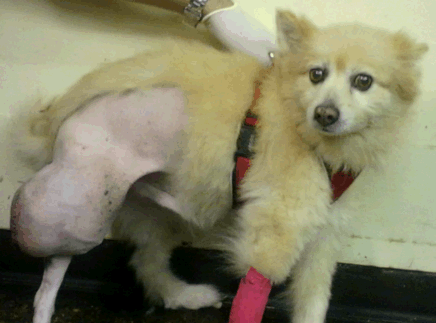|
HEMANGIOPERICYTOMA

WHEN THE DIAGNOSIS IS HEMANGIOPERICYTOMA
The hemangiopericytoma is a common tumor in the dog, usually arising on the limbs and appearing as a round nodule under the skin. It derives from a cell called a "pericyte" which acts to support blood vessel capillaries throughout the body (see below). A pericyte somewhere in the body develops a chromosomal abnormality (either a missing chromosome or an extra one) and begins to proliferate and invade other local tissues thus forming a hemangiopericytoma. The hemangiopericytoma is classified as a type of soft tissue sarcoma and is considered malignant because of its ability to invade and obliterate local tissues; however, it rarely spreads to distant body sites. Hemangiopericytomas can appear bald, pigmented or even ulcerated. In later stages, the hemangiopericytoma can be quite large and is sometimes mistaken for a benign lipoma (fatty tumor) if tests are not performed.
WHAT IS A PERICYTE?
|
Consider that everyone began life as a single cell. This cell divided over and over and became many cells. As time continued, we became groups of different types of cells. Eventually we became embryos, fetuses, and finally infants with complete organ systems and different tissues all derived from one original cell. During the course of this amazing development, some cells do not specialize fully into specific tissues. They stay "undifferentiated" and can in the future specialize into whatever type of cell our body might require at that time. We have cells throughout our bodies that simply "stayed put" at different stages of embryonic development. Pericytes are such cells. They have arrested their development from embryonic times and are located all over the body supporting blood vessels and waiting for a signal to develop. If the body has need, pericytes can develop into new muscle tissue or new blood vessel tissue. A pathology instructor once described the pericyte as perhaps not the Adam and Eve of our bodies but more like Abraham.
|

Pericytes grip and support the blood vessel
(original graphic by marvistavet.com)
|
WHAT IS A HEMANGIOPERICYTOMA?
A hemangiopericytoma is a tumor arising from pericytes associated with blood vessels. Instead of forming a useful tissue, these pericytes form tumors because improper cell division has left them with chromosome damage.

Gerry has a hemangiopericytoma on the right rear leg
(original graphic by marvistavet.com)
IS IT CANCER?
The hemangiopericytoma does not spread through the body in the way one normally thinks of cancer. It does, however, tend to recur at the site of its original removal. When it recurs, it tends to grow back more deeply rooted and more difficult to remove than it was in its original form. Exactly how aggressive a particular tumor can be expected to behave will depend on several factors: how bizarre the cells appear under the microscope, whether the tumor has an area of dead tissue or not, and how rapidly its cells are dividing. All these factors are judged by the pathologist reading the biopsy and are translated into a grading system where Grade I is the slowest growing and least aggressive, Grade III is the most aggressive and Grade II is an intermediate form. If the tumor is left alone, it will eventually become inoperable, disfiguring, and lethal though this could take many years depending on its body location and grade.
WHAT ARE THE TREATMENT OPTIONS?
Treatment centers around local tumor control and this usually means surgery. A small hemangiopericytoma might be removable. A larger one could be partially removed. The problem is that the hemangiopericytoma is a blood vessel tumor. Bleeding can be spectacular with the larger growths and surgery becomes risky. The first step involves some sort of biopsy, either an attempt at removing the whole tumor or simply a mission to take a small piece and identify the tumor depending on the tumor size and amount of bleeding encountered. Once the growth is confirmed as hemangiopericytoma and the bulk of the tumor has been removed, the focus becomes slowing its growth/preventing recurrence. Here are the options after the initial surgery:
- Radiation therapy
The hemangiopericytoma is responsive to radiation therapy. This means that the cure rate after radiotherapy is 80-90% assuming the tumor has been reduced to microscopic size after surgical removal. Only the tumor site receives radiation in this type of therapy so the patient does not become ill though the area of radiation exposure will probably lose the ability to grow hair. Effective (definitive) radiation therapy unfortunately requires 15-18 treatments and the total cost in our area can easily run $4000-$4500. For radiotherapy to be effective, the tumor must first be surgically removed without visible remaining tumor present; otherwise the tumor is will be too big for a definitive response.
If the goal is not to cure the tumor but to simply slow its recurrence, "palliative" radiation is an option. This costs substantially less and typically involves a month of weekly treatments. This might not be able to prevent regrowth of the tumor but could certainly postpone it. Given that the tumor is slow growing to begin with, postponing regrowth might be as good as a definitive response.
- Leave tumor alone for now and attempt another surgical removal when it recurs.
One option is to wait and see if the tumor regrows (it usually does). When it regrows, it can be re-removed; however, when it re-grows, it is usually more difficult to remove. Every time it is removed, it re-grows more invasively making the next surgery more difficult. If a second surgery removes the visible portions of the tumor successfully, radiation therapy can again be considered as above with similar success rate.
- Leave tumor alone, let it grow back, do nothing.
This may be a realistic option for an elderly patient as the hemangiopericytoma typically requires 6-12 months to grow back and longer to become disfiguring or invasive. An older patient may die of old age before the hemangiopericytoma comes back in a meaningful way. For a younger patient, however, this is probably a poor option as the tumor will eventually become, as mentioned, inoperable, disfiguring, and lethal. In this situation, a more definitive plan is better.
- Allow the tumor to recur then amputate the limb (assuming the tumor is on a limb).
This may seem extreme but it certainly resolves the lethal aspect of the tumor in a curative manner. The hemangiopericytoma does not spread distantly in the body so amputation of the limb achieves cure and does so far less expensively than radiotherapy, though amputation is a major surgery and can still be expected to cost $2000-$3000 in our area.
- Metronomic Chemotherapy
Metronomic chemotherapy involves the use of chemotherapy drugs at very small doses daily or at least much more frequently than the traditional chemotherapy protocols would have them used. For incompletely removed hemangiopericytomas, the goal of metronomic chemotherapy is to hamper the regrowth of the remaining tumors blood supply. The most common protocols use a combination of cyclophosphamide and piroxicam. This type of treatment is not generally helpful when grossly visible tumor is present but is best for preventing the re-growth of a tumor after all its visible portions have been removed.
WHAT ABOUT INOPERABLE TUMORS?
Some tumors are just too big, are located in a body area not amenable to surgery, or the patient has concurrent problems that make surgery problematic. If surgery is not practical, there are still treatment options to consider:
- Palliative radiation therapy
As described above, a less aggressive radiation plan can be used to retard the growth of the tumor. This can be very helpful in managing pain, preventing ulceration, and slowing enlargement of the mass. A typical plan might be weekly treatments for a one month period.
- Electrochemotherapy
This is a newly emerging technique for managing solid tumors not amenable to surgery. Here, electricity is used to temporarily generate pores in the tumor through which chemotherapy agents can penetrate. This method provides much more efficient chemotherapy penetration than simply letting the tumor take up the chemotherapy agent naturally. The strength of the electricity is can also be strong enough to damage the tumor. At this time electrochemotherapy is only available in select institutions.
If your dog has been diagnosed with a hemangiopericytoma, you may want to be referred to an oncologist for the most up to date recommendations. Veterinary oncologists are certified by the American College of Veterinary Internal Medicine. To locate an oncologist in your area visit:
http://vetcancersociety.org/pet-owners/find-a-vcs-member/(if link doesn't work, cut and paste into a new browser window)


Page last updated: 2/9/2022
|